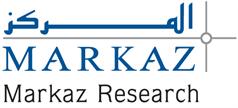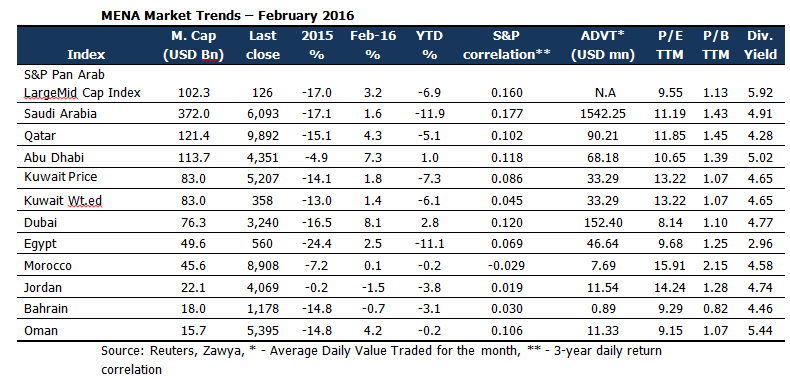
Kuwait Financial Centre “Markaz” recently released its Monthly Market Research report. In this report, Markaz examines and analyzes the performance of equity markets in the MENA region as well as the global equity markets for the month of February.
February was a good month for MENA markets, as nearly all indices ended the month in green. Dubai (8.1%) and Abu Dhabi (7.3%) indices lead the charge, while Bahrain (-0.7%) and Jordan (-1.5%) lagged behind. Kuwait price (1.8%) and weighted (1.4%) indices fared well, after facing one of the worst starts to a year since 2009. Brent crude price improved marginally to close the month at USD 35.97 per barrel, up 3.5% from previous month’s close. Reflecting the change in fortunes, S&P GCC also improved by 3.7% in February, to close at 88 points.

Momentum trading led to investors chasing small- and mid-cap stocks in the UAE stock exchanges, as investor confidence soared over speculation that the oil price had bottomed out. Steps, such as finding consensus for production cuts, are being taken to stabilize oil price, which lifted investor sentiments, and the fact that most of the stocks were available at a discount after the January fall directed investors in droves to the markets. Real estate and construction-related sectors performed well, led by Arabtec, which rose 20% in February.
MENA markets liquidity had a positive month, with volumes increasing by 17% and value traded rising by 10%. Abu Dhabi, Morocco and Bahrain witnessed increases in both volume and value traded, while Egypt, Kuwait and Jordan were the only markets to record declines in both. Volume and value traded in Abu Dhabi increased by 172% and 59%, respectively, while the Kuwait bourse witnessed a 16% volume and 30% value drop.
Most Blue Chips ended the month of January in green, with Americana (Kuwait) topping the charts at 29.5%, as speculation peaked about the selling of the controlling stake to an investment firm. It was followed by Emaar Properties (UAE, 14.5%) and First Gulf Bank (UAE, 12.3%). While Emaar Properties announced a healthy 11% increase in earnings for 2015, despite a write down in the last quarter due to a fire in one of its properties, the latter announced an 11% increase in Q4 profit; one of the few bright spots, in what has been a disappointing earnings season for Abu Dhabi banks. Emirates NBD (UAE, -5.7%) and NCB (Saudi, -5.7%) lagged behind the rest of the blue chips in the region. In February, shareholders of Emirates NBD have approved the bank’s proposal to raise its euro medium-term note programme to USD 12.5bn, from the previous USD 7.5bn, and also to establish any similar debt programme, in the future. Saudi’s NCB announced that it will be closing two branches in Beirut, Lebanon due to their low financial returns.
Bond Issuances and Credit Rating Downgrades
In 2016, GCC sovereigns, are looking to issue syndicated loans financed by international banks. Qatar is seeking USD 10bn, and is turning to international debt markets to shore up its finances that are pressured by low energy prices. The country is in talks with banks about a sovereign sukuk issue, and is looking to cover its USD 12.8bn deficit by using a combination of international loans and bond sales.
Bahrain launched a USD 600mn, two-part bond sale, offering a higher yield than it did for the previously cancelled USD 750mn debt sale, after the kingdom's credit rating was downgraded to junk status by Standard & Poor's. S&P also downgraded Saudi Arabia, Bahrain and Oman, in its second mass cut of large oil producers in almost exactly a year, citing the pressures being created by the drop in oil prices. Saudi Arabia was downgraded two notches to A- negative from A+ stable.
Moody's Investors Service sharply cut Oman's sovereign credit rating by two notches to A3, just weeks before the country may launch its first international bond issue in nearly 20 years, citing damage to state finances from low oil prices. It also kept the rating on review for a further downgrade, saying the country, a small exporter of crude, had fewer financial reserves than its rich neighbors to cope with an era of cheap oil.
Oil Market Review
Brent crude hit a high of USD 37 per barrel before closing the month at USD 36 per barrel, up 3.5% from January. China’s measures to revive its slowing economy, a drop in crude output from OPEC and the US, and many OPEC members issuing statements in support of a production cut led to rise in prices. Output from the OPEC fell the most in February in recent history, as Saudi Arabia, working alongside with Venezuela, Qatar and Russia on a plan to freeze oil output, pledged to control crude market volatility.
###
About Kuwait Financial Centre “Markaz”
Kuwait Financial Centre K.P.S.C “Markaz”, established in 1974, is one of the leading asset management and investment banking institutions in the Arabian Gulf Region with total assets under management (AUM) of over KD1 billion as of December 31, 2015 (US3.44 billion). Markaz’ shares are listed on the Kuwait Stock Exchange (KSE) since 1997.
For further information, please contact:
Alrazi Al Budaiwi
Media and Communication
Kuwait Financial Centre K.P.S.C "Markaz"
Tel: +965 2224 8000 ext. 1800
Fax: +965 2249 8740
Email: [email protected]
Url: www.markaz.com

